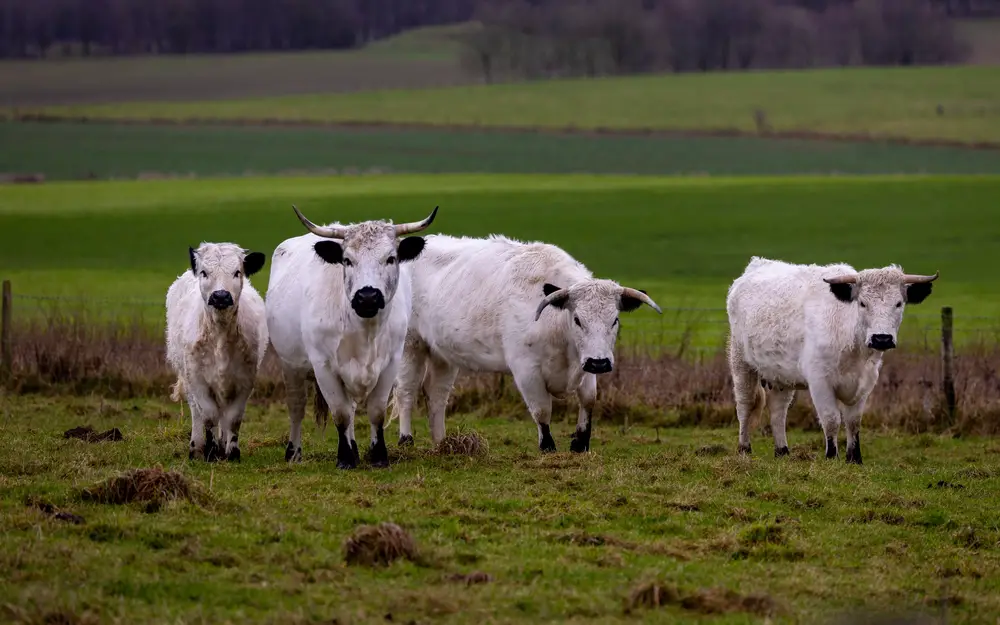White Park Cattle are a dual-purpose longhorn heritage breed of cattle from Great Britain that descended from wild white cattle. They are considered a British national treasure and are a hardy breed known for aggressive grazing, docility, adaptability, excellent milk, and exceptional beef.
This guide will help you decide if this breed is right for your farm.
Table of Contents
Where Does White Park Cattle Come From?
White Park Cattle are descended from wild breeds of horned, white cattle that were originally used for sport in the areas that now make up the United Kingdom including England, Scotland, and Wales.
Cadzow, Chillingham, Dynevor, and Vaynol were deer park areas in Britain where some of these cattle herds were ultimately enclosed. It is these herds that survived when surrounding native lands became lost due to a rising human population.
Cattle breeds such as British White cattle and White Park cattle ultimately became domesticated, but unlike most domesticated cattle, they evolved naturally, with little human interference.
The Park Society was created in 1918 and they established the first herd book for White Park cattle. Several other breeds were included in this book including polled and horned white cattle breeds.
Importation of White Park cattle to North America happened during World War II in an effort to conserve the breed during wartime. They were originally kept at the Bronx zoo in New York before ultimately being sent to King Ranch in Texas for long-term keeping.
While the development of the American White Park cattle also took place after WWII but they are a polled, selectively bred variant on the original White Park cattle from Britain and though similar in looks, have different traits.
The genetics of ancient White Park cattle are far removed from any other cattle breed, and it is for this reason that preservation of this species is so important.
Conservation efforts are currently being made by both the Rare Breeds Survival Trust, and the Livestock Conservancy for ancient White Park cattle that have a low population worldwide and are currently endangered.
White Park Cattle Breed Characteristics
| Official Breed Name | White Park Cattle |
| Scientific Name | Bos taurus |
| Origin | England |
| Appearance | Either red points or black points on a white, mottled, or black coat. Black and mottled varieties are rare and linked to a recessive color gene. White Park cows have elegantly twisted lyre-shaped horns while bulls have shorter, forward-facing horns. |
| Calf Weight | 70lbs to 80lbs |
| Mature Cow Weight | 1000lbs to 1200lbs |
| Mature Bull Weight | 1500lbs to 1800lbs |
| Ready To Breed | 13 to 15 months |
| Gestation Period | 279 to 287 days |
| First Calvings | Around 2 years |
| Time to Slaughter | 2+ years |
| Carcass Weight | 730lbs |
| Expected Lifespan | 20 to 25 years |
| Productive Lifespan | 12 to 16 years |
| Known For | Highly alert and active Easy calving Efficient grazers Cows have a docile temperament |
| Weaknesses | Calves are slow to reach adult weight (5+ years) Bulls have been known to be aggressive Milk production not suited for commercial operations |
| Climate | Good for all climate types |

What Is So Special About White Park Cattle?
1. Genetic Advantage
White Park cattle are unlike any other cattle breed on earth genetically. They are an ancient breed with ancestors who lived off the land as wild cattle and have exceptional hardiness as a result.
White Park bulls can be used as crossing sires to share the hybrid vigor and ease of calving that the breed is known for.
2. Beef Production
White Park cattle are technically dual-purpose but are especially prized as a grass-fed beef breed.
In their use as beef cattle, they are able to turn low-quality forage into lean, high-quality beef with beautiful marbling.
Properly hung beef of White Park cattle has little joint shrinkage during the cooking process and provides an excellent eating experience that is flavorful and juicy. In the United Kingdom, only top restaurants and butcheries provide beef from White Park cattle.
Ancient White Park cattle were crossed with Angus beef cattle to create American White Park cattle in order to produce unparalleled beef cuts with exceptional carcass quality and high yields. Tests conducted by the USDA gave them a Yield Grade of 2.34 and an average Choice quality grade.
3. Milk Production
In their use as a milking breed, White Park cows are average milk producers and suitable for use on small farms. It should be noted that they do not produce enough milk for commercial operations.
They have nicely formed udders and their teats hold shape nicely, allowing for the suckling of calves and milking.
Why Should I Raise White Park Cattle On My Farm?
- Hardiness – highly resistant to disease and parasites
- Adaptability to most climates
- Low maintenance breed due to excellent foraging ability
- Known for exceptional longevity due to their hardiness
- A highly fertile breed that calves easily
- Calves are strong, quick to suckle, and highly active – calf loss is rare
- Cows are excellent mothers and have good maternal instincts
- Cows are highly protective of their young
- They produce a moderate amount of high-quality milk, more than enough for calves
